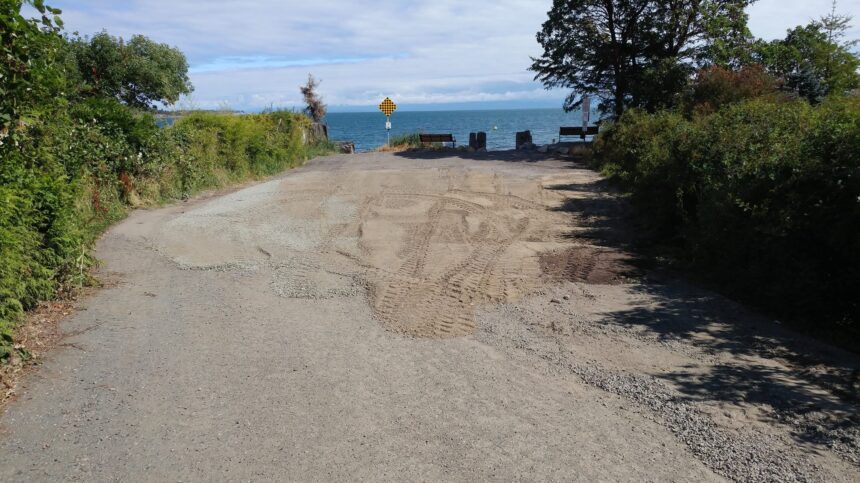As I watched families pack their beach bags last weekend at Willows Beach, no one seemed to notice the small sign posted near the pathway entrance. The warning, advising against swimming due to elevated bacteria levels, fluttered slightly in the breeze while children nearby built sandcastles at the water’s edge.
“We come here every Saturday,” explained Victoria resident Mariam Khatib, adjusting her sun hat while keeping an eye on her two young daughters splashing in the shallow water. “I had no idea there was an advisory. The signage isn’t exactly obvious unless you’re looking for it.”
This scene has become increasingly common across Vancouver Island as Island Health expanded its beach advisories this week to include three additional locations: Willows Beach in Oak Bay, Ross Bay Beach in Victoria, and Transfer Beach in Ladysmith. These join previously issued warnings for Departure Bay Beach, Nanaimo River Estuary, and Kin Beach in Comox.
The growing list of advisories stems from routine water quality testing that revealed high counts of enterococci bacteria, which can cause gastrointestinal illness, ear infections, and skin rashes for swimmers. According to Island Health’s environmental health officer Kelly Smith, whom I spoke with by phone, these elevated levels typically follow extended periods of warm weather.
“What many beachgoers don’t realize is that bacteria thrive in warm, shallow waters,” Smith explained. “When we get several weeks of heat like we’ve had, combined with minimal rainfall to flush systems, conditions become ideal for bacterial growth.”
My conversation with Smith revealed another critical factor that’s less understood by the public: these advisories don’t necessarily indicate pollution events or sewage spills. Natural sources, including bird droppings from the large populations of Canada geese that frequent island beaches, contribute significantly to bacterial counts.
Data from Environment and Climate Change Canada shows that elevated bacteria levels at coastal recreational waters have increased by approximately 26% across British Columbia over the past decade. This trend aligns with rising average summer temperatures and longer dry spells between rainfall events, patterns consistent with climate change projections for the region.
Dr. Natalie Prystajecky, program head for environmental microbiology at the BC Centre for Disease Control, points to multiple factors behind this trend. “We’re seeing a complex interplay between warmer water temperatures, changing precipitation patterns, and in some cases, aging infrastructure that can’t handle increased pressure from growing coastal populations.”
When I visited Transfer Beach in Ladysmith on Tuesday, the advisory sign was more prominently displayed, but still, several swimmers ignored the warning. Local resident Jeff Martineau, who’s lived in the area for over 30 years, expressed frustration while walking his dog along the shoreline.
“I’ve never seen this many advisories in a single summer,” he said, gesturing toward the water. “This beach is central to our community life. Kids learn to swim here, families celebrate here. These closures impact more than just recreational swimming—they affect our sense of place.”
Island Health officials emphasize that the advisories are recommendations, not enforcement actions, making community awareness and voluntary compliance essential. Testing occurs weekly, with advisories lifted once bacteria levels return to acceptable standards—below 70 enterococci per 100 milliliters of water, as established by Health Canada guidelines for recreational water quality.
For communities dependent on summer tourism, these advisories carry economic consequences. The Vancouver Island Economic Alliance estimates that beach-related tourism contributes approximately $46 million annually to local economies, with peak revenue generation occurring during July and August.
Caroline Grover, who owns a beachside café near Ross Bay, has noticed a decline in business since the advisory was posted. “We’ve seen about a 20% drop in customers this week compared to the same time last year,” she told me as we sat on her café’s patio overlooking the nearly empty beach. “People come for the beach experience. When they can’t swim, many just don’t come at all.”
Public health experts and environmental advocates agree that increased public education about beach water quality could help communities better navigate these advisories. The Vancouver Island Health Authority currently posts updates on their website and social media channels, but many residents I spoke with weren’t aware of these resources.
Kelly Chang, director of the Island Water Watch Network, has been advocating for improved notification systems. “Other jurisdictions use color-coded flags or digital displays that make water quality status immediately visible,” Chang explained during our meeting at a local community center. “We also need better explanation of what these advisories mean—swimming isn’t recommended, but wading might be fine, depending on your health status.”
As climate patterns continue to shift, coastal communities across Vancouver Island may need to adapt to more frequent beach advisories. Health authorities are considering extending testing periods beyond the traditional May-to-September window as warmer temperatures stretch swimming seasons.
Back at Willows Beach, I noticed a family reading the advisory sign before reluctantly packing up their beach gear. Their disappointment was visible as they explained to their children why they couldn’t swim today. It was a small moment that captured a larger reality: our changing relationship with coastal spaces that have long defined Vancouver Island’s identity and community life.
For now, Island Health recommends checking their website before heading to beaches and observing posted advisory signs. Officials expect the current advisories to remain in place for at least another week, pending future test results.






